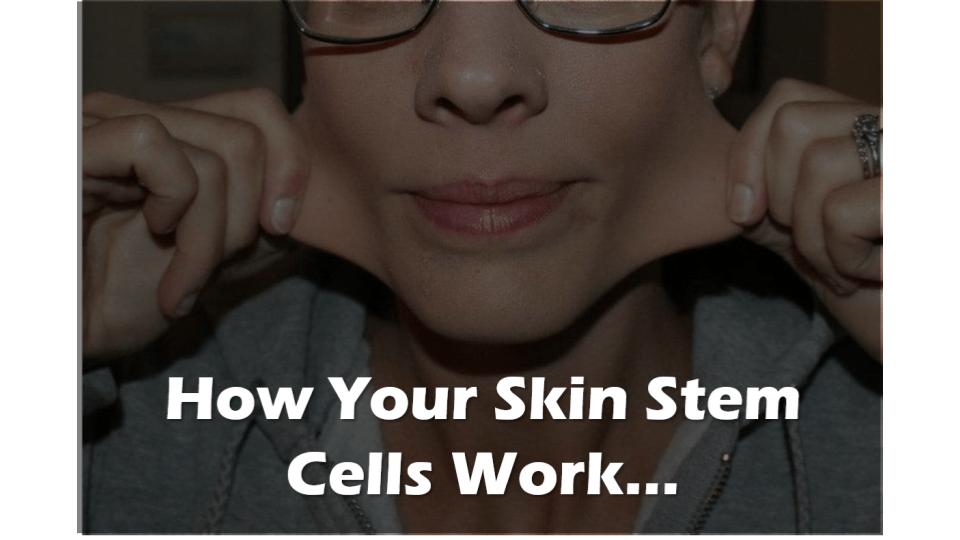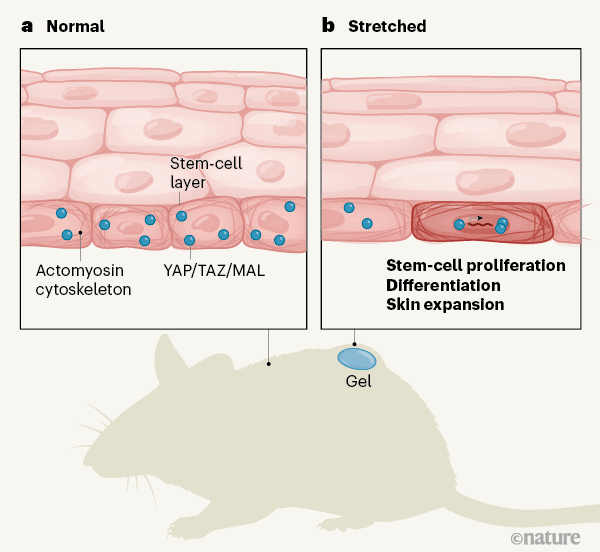Stretching the Skin Activates Stem Cells that Make New Skin

Stem cells live all over our bodies. They maintain and repair our bodies and do so many other things. Now a new study shows that they help our skin grow and adjust to our bodies. Let’s dig in.
Stem Cells and Life
Stem cells are all over our bodies. If you’re alive, your stem cells are working just fine. In fact, without them doing their thing you’d be 6 feet under in weeks.
What Do Your Stem Cells Do?
Let’s take your stem cells to the gym and since most are closed, let’s say a home gym. You run on the treadmill. Despite your best efforts, you kill off cartilage cells in your knees and the superficial cells stem cells on the surface of your cartilage repairs that damage (1). You lift heavy weights and the muscle cells get ripped up. Satellite stem cells located in the muscles repair that damage and make your muscles stronger (2). You hit a yoga class and stress some knee ligaments and kill off a few ligament cells and the stem cells in those ligaments repair and strengthen that ligament (3).
What Else Can They Do?

A new paper in the journal Nature suggests a new role for your stem cells (4). They also help adjust your skin tension. How does that work?
Doctors have exploited the fact that when you stretch the skin, that makes more skin. For example, surgeons have used this method for decades by implanting something under the skin to stretch it and then harvesting the extra skin for grafts. However, nobody has really known exactly how this works, until now. Turns out, it involves special stem cells.
How Does This Work?
There are stem cells in the bottom layer of your skin. Stretching of the skin tips the balance of their activity to make more stem cells. The researchers demonstrated that force alters the stem cells at the molecular level in several ways. First, the skeleton of the stem cell (actin-myosin) picks up on the fact that it’s being stretched. This deformation then creates chemical signals for the stem cells to grow by altering gene expression.
The upshot? The stem cells in your body do all sorts of things, not the least of which is to keep you alive and from falling apart. These cells also have many other functions we’re just starting to work out!
_______________________
References:
(1) Jiang Y, Tuan RS. Origin and function of cartilage stem/progenitor cells in osteoarthritis. Nat Rev Rheumatol. 2015;11(4):206-212. doi:10.1038/nrrheum.2014.200
(2) Yin H, Price F, Rudnicki MA. Satellite cells and the muscle stem cell niche. Physiol Rev. 2013;93(1):23-67. doi:10.1152/physrev.00043.2011
(3) Lee KJ, Clegg PD, Comerford EJ, Canty-Laird EG. Ligament-Derived Stem Cells: Identification, Characterisation, and Therapeutic Application. Stem Cells Int. 2017;2017:1919845. doi:10.1155/2017/1919845
(4) Rübsam M, Niessen CM. Stretch exercises for stem cells expand the skin [published online ahead of print, 2020 Jul 29]. Nature. 2020;10.1038/d41586-020-02158-y. doi:10.1038/d41586-020-02158-y

If you have questions or comments about this blog post, please email us at [email protected]
NOTE: This blog post provides general information to help the reader better understand regenerative medicine, musculoskeletal health, and related subjects. All content provided in this blog, website, or any linked materials, including text, graphics, images, patient profiles, outcomes, and information, are not intended and should not be considered or used as a substitute for medical advice, diagnosis, or treatment. Please always consult with a professional and certified healthcare provider to discuss if a treatment is right for you.